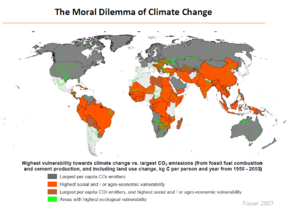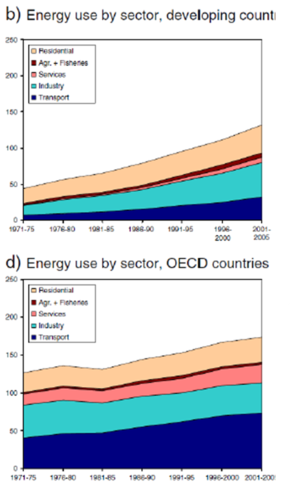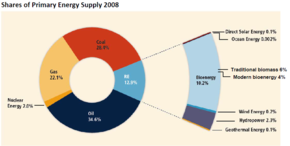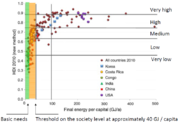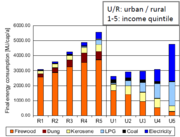Difference between revisions of "Microenergysystems in the Context of Climate Change and Economical Development - A Valuable Proposition?"
***** (***** | *****) |
***** (***** | *****) |
||
| Line 29: | Line 29: | ||
The second graph shows the correlation of the wealth of a country in US $2,000 per person and its carbon debts in kilograms carbon emitted per person and year. Countries are closely positioned around the fitting line. This suggests, that wealth and emission of CO2 presuppose each other. Further research has been carried out to see whether development has to come together with increased CO2 emissions.<br/> | The second graph shows the correlation of the wealth of a country in US $2,000 per person and its carbon debts in kilograms carbon emitted per person and year. Countries are closely positioned around the fitting line. This suggests, that wealth and emission of CO2 presuppose each other. Further research has been carried out to see whether development has to come together with increased CO2 emissions.<br/> | ||
| + | |||
= Development, Emissions and their Drivers = | = Development, Emissions and their Drivers = | ||
| − | + | [[File:Energy Use OECD and Developing.png|thumb|290px|Energy Use OECD and Developing Countries]] | |
| − | + | [[File:Shares of Primary Energy.png|thumb|290px|Shares of Pimary Energy]] | |
| − | [[File:Energy Use | + | The first graph shows how the use of energy differs in developing and OECD countries and shows a development from 1971 to 2006. Clearly, developing countries have raised their <br/> |
Revision as of 10:40, 5 December 2013
| ► | Back to the Lecture Series: Energy in Development |
Page in Progress
Presentation
Climate Change Mitigation
Dr. Jan Steckel is one of these important researchers working on the IPCC report. At the moment the report gets updated - numbers and figures that are most recent have to be juggled.
These new numbers conclude on a well-known picture:
- Developing countries suffer most from climate change.
- Developed countries cause it.
The grey sections in the map on the right show the largest CO2 emitters, the red countries are most vulnerable to climate change in social and/or agro-economic sectors. Most countries are either responsible for or suffer under climate change - few emitters suffer themselves. The developing countries both see the most dramatic changes of their local climats and they are also less prepared to adapt to climate changes.
It is a moral dilemma: the south suffers, the north emits the CO2 and the business as usual scenarios see an increase of emissions.
The second graph shows the correlation of the wealth of a country in US $2,000 per person and its carbon debts in kilograms carbon emitted per person and year. Countries are closely positioned around the fitting line. This suggests, that wealth and emission of CO2 presuppose each other. Further research has been carried out to see whether development has to come together with increased CO2 emissions.
Development, Emissions and their Drivers
The first graph shows how the use of energy differs in developing and OECD countries and shows a development from 1971 to 2006. Clearly, developing countries have raised their
Energy and Development
Energy System Transformations – Opportunities, Trade‐offs and Risks
Conclusions
- Development and carbon emissions highly correlated
- At current (relative) prices of fossil fuels it is not realistic to expect a decarbonization of development patters in the short term (without policy intervention)
- Low carbon technologies, particularly renewable energy not cost competitive in the short run
- Even on smallest scale, high income threshold
- Strategies to decarbonize energy systems on large scale are necessary and feasible, but might collide with other development goals
- Short term strategy: Improve institutional quality and provide minimum access to basic infrastructures to help the poor
Further Information
- Doll, Christopher N.H. and Pachauri, S. (2010): Estimating rural populations without access to electricity in developing countries through night‐time light satellite imagery. Energy Policy, 38(10), pp. 5661‐5670.
- Edenhofer et al. (2011): Renewable Energy in the Context of Sustainable Development. In IPCC Special Report on Renewable Energy Sources and Climate Change Mitigation.
- GEA (2012): Global Energy Assessment – Toward a Sustainable Future, Cambridge University Press, Cambridge UK and New York, NY, USA and the International Institute for Applied Systems Analysis, Laxenburg, Austria.
- Grübler, A., 2004. Transitions in energy use. In: Cleveland, C.G. (Ed.), Encyclopedia of Energy, Vol. 6. Elsevier.
- IEA (International Energy Agency) 2010, World Energy Outlook 2010, OECD/IEA, Paris.
- Jakob, M., M. Haller, R. Marschinski (2012): Will History Repeat Itself? Economic Convergence and Convergence in Energy Use Patterns. Energy Economics 34, p. 95‐104.
- Jakob, M., R. Marschinski, M. Hübler (2013): Between a Rock and a Hard Place: A Trade‐Theory Analysis of Leakage under Production‐ and Consumption‐Based Policies. Environmental and Resource Economics, forthcoming.
- Jakob and Steckel (2013): How climate change mitigation could harm development in poor countries. WIREs Climate Change, forthcoming.
- Knopf, Brigitte; Yen‐Heng Henry Chen, Enrica De Cian, Hannah Förster, Amit Kanudia, Ioanna Karkatsouli, Ilkka Keppo , Tiina Koljonen, Katja Schumacher, Detlef P. van Vuuren: Beyond 2020 ‐ Strategies and costs for transforming the European energy system. Overview paper of the EMF28 model comparison of the EU Energy Roadmap, Climate Change Economics.
- Luderer G, Krey V, Calvin K, Merrick J, Mima S, Pietzcker RC, Vliet J van, Wada K (2013): The role of renewable energy in climate stabilization: results from the EMF27 scenarios. Clim Change, in press.
- Schäfer, A. (2005): Structural change in energy use, Energy Policy, 33(4), pp. 429‐437.
- Steckel, J., M. Jakob, R. Marschinski and G. Luderer (2011): From carbonization to decarbonization? Past trands and future scenarios for China’s CO2 emissions. Energy policy, 39 (6), pp. 3443‐3455.
- Steckel, J, RJ Brecha, M. Jakob, J. Strefler, G. Luderer (2013): Development without energy? Assessing future scenarios of energy consumption in developing countries. Ecological Economics, 90, pp. 53‐67.
- David I. Stern. (2011): The role of energy in economic growth in “Ecological Economics Reviews.” Robert Costanza, Karin Limburg & Ida Kubiszewski, Eds. Ann. N.Y. Acad. Sci. 1219: 26–51.
References

